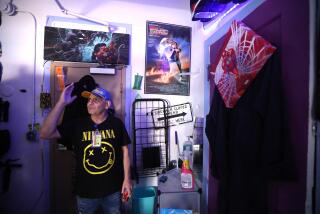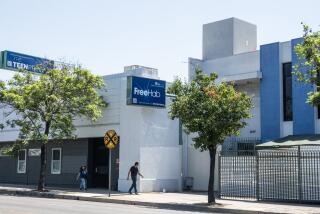Thousands of Addicts, Felons Find New Life in Delancey St. Foundation
SAN FRANCISCO — When Christine Hill looks at the past, she sees herself at 18, a woman who had hit rock bottom and couldn’t climb up.
“I was doing things I swore I would never do--’I’d never stick a needle in my arm’ or ‘I’d never sleep with somebody for some money’--things that petrified me, and I didn’t know how to not do it anymore,” she said.
Six years later, Hill enjoys a present she thought she’d never live to see and envisions a future without drugs or fear, full of once-unimaginable responsibility and success.
For 19 years, thousands of refugees from troubled lives--alcoholics, drug addicts and ex-cons--have found renewal in the Delancey Street Foundation, a rigorous self-help program named for a street on New York City’s Lower East Side.
The foundation modeled itself after the turn-of-the-century neighborhoods where immigrants from the Old World built their futures, foundation President Mimi Silbert said.
“A lot of people came to this country with a dream, and individually they didn’t know how to make the dream happen, but collectively they did,” she said. “They took care of each other. They were like an extended family.”
The nonprofit program was started in San Francisco by John Maher, an eighth-grade dropout from an Irish slum in the Bronx who said he borrowed the $1,000 start-up money from a loan shark. Maher, then 31, had been an alcoholic and a heroin addict and served time for robbery and larceny.
Delancey Street, which shuns government handouts, has grown to more than 800 residents in four states, has an operating budget of $7 million and plans to build a $30-million apartment complex to handle the overflow of participants.
The program’s methods are deceptively simple, Silbert said.
“We teach them everything they need to know in order to learn how to live,” she said. “There is nothing complicated about Delancey Street except the commitment to do it all and do it real.”
Substance abusers or felons, with the exception of repeat sex offenders, are admitted if they make the same commitment. They first enter what the group calls “immigration,” joining a strict “family” for at least two years.
Established members teach newcomers through patience and example to trust and care about others, be responsible and believe in themselves.
“There is nothing phony about it at all. People have been through the same thing you have--in prison, in jail or as a drug addict,” said resident Gary Campbell, 31, a former burglar and methamphetamine user who is learning construction work while helping build the foundation’s new home.
For isolated, scared and angry people who never believed that they could change, learning those lessons takes great courage, Silbert said. About a fourth drop out, some unwilling to go along with the rules, others admitting they can’t change, she said.
But for those who stay, Delancey Street succeeds largely because the program does not treat addiction, lack of skills or antisocial behavior as separate problems, residents said.
“The program really focuses on curing the whole person,” said program graduate Rick Mariano, 42, a former heroin addict who is now a partner in a commercial real estate firm. “They really do understand that a drug problem is symptomatic of a failure of a person to fashion some sort of noble and decent life.”
Many participants cannot read or write, so other residents teach them. They also earn high school diplomas or attend local colleges and are trained in job skills through the foundation’s various businesses, including Christmas tree lots and “advertising specialties,” the sale of imprinted pens, sweat shirts and other items to college bookstores.
Hill, who joined Delancey Street in New Mexico, started as a typist in the organization’s supply department, became a “hustler” seeking donations, then opened a foundation sales office.
For the last two years, she has been in San Francisco, where she has worked in advertising specialties. Ready to seek her first “outside” job, a final step toward graduation, the former amphetamine user who once could not imagine a future now projects becoming a sales executive earning more than $50,000 a year.
“I thought I would be dead,” she said. “I would be dead. I never saw myself doing as much as I can do now.”
Delancey Street raises about half its operating funds through its businesses and gets the rest in donations of cash or goods. Supporting a resident in San Francisco or in foundation homes in New York, Los Angeles, Espanola, N.M., or Greensboro, N.C., costs about $10,000 annually--a quarter to half the cost of keeping someone in jail, Silbert estimated.
The program has earned praise from government and law-enforcement officials.
“Anyone who can take a non-productive citizen . . . and turn them around and make them part of society, that says something about the organization,” said San Francisco Police Capt. Paul Kotta, whose territory includes Delancey Street’s current apartment building.
Wayne Clark, who runs the city’s substance-abuse programs, which often make referrals to Delancey Street, praised the foundation for having former addicts run the program and creating a homelike but strictly drug- and alcohol-free environment.
“I wish we could be doing for all . . . addicted people what they do,” he said. “If you had something like this nationwide, you’d make a significant dent in the problem.”
But Delancey Street now turns away more than 90% of its applicants because of a lack of space, Silbert said.
The new apartment complex is being built on the San Francisco Bay waterfront almost entirely by the people who will live there, and will enable the foundation to accommodate twice the 350 residents now crowded into two buildings.
“It’s a hell of an accomplishment, we feel,” said Abe Irizarry, 46, a foreman at the project whose only previous construction experience was helping pour the concrete handball court at San Quentin Prison.
Maher, Delancey Street’s founder, rebuilt his own life, but resumed drinking in the early 1980s. He resigned from the foundation to undergo treatment, suffered a series of heart attacks and died in his sleep in 1988 at age 48.
Silbert, 47, co-president with Maher since 1972, now runs the foundation with a board of directors.
Unlike Maher, with whom she lived for more than 10 years, her upbringing in Brookline, Mass., was happy and secure and her life free of drug or alcohol problems.
“I grew up in the kind of life that leaves a person like me feeling so guilty,” she said. “I got these parents who would make anybody healthy, and these other people didn’t get this chance in life. I feel I’m trying to catch up on that score.”
More to Read
Sign up for Essential California
The most important California stories and recommendations in your inbox every morning.
You may occasionally receive promotional content from the Los Angeles Times.










